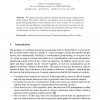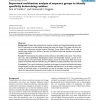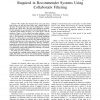393 search results - page 7 / 79 » Identifying Most Predictive Items |
HT
2010
ACM
13 years 9 months ago
2010
ACM
Online social sharing sites are becoming very popular nowadays among Web users, who use these sites to share their favourite items and to discover interesting and useful items fro...
AIPS
2009
13 years 8 months ago
2009
N-gram analysis provides a means of probabilistically predicting the next item in a sequence. Due originally to Shannon, it has proven an effective technique for word prediction i...
WADS
2005
Springer
14 years 28 days ago
2005
Springer
We study practically efficient methods for performing combinatorial group testing. We present efficient non-adaptive and two-stage combinatorial group testing algorithms, which i...
BMCBI
2007
13 years 7 months ago
2007
Background: Proteins that evolve from a common ancestor can change functionality over time, and it is important to be able identify residues that cause this change. In this paper ...
CISS
2008
IEEE
2008
IEEE
A lower-bound on the number of rankings required in recommender systems using collaborativ filtering
14 years 1 months ago
— We consider the situation where users rank items from a given set, and each user ranks only a (small) subset of all items. We assume that users can be classified into C classe...



